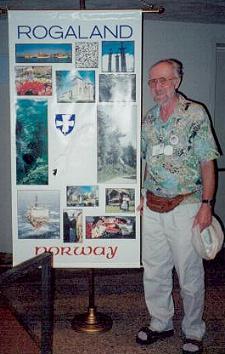|
|
C. Bygdelag, Day 2:
The second day we were again up early hoping to get a photo of all the tents of the bicyclists covering the lawns, but they had pretty much packed up and were gone in the cool of first light. That morning we attended excellent forum sessions of noted speakers. Keith attended one by a most noted author on Norwegian-Americans and another by the recently retired curator of the Vesterheim Museum. After lunch in the cafeteria, we drove into Decorah where we spent the afternoon exploring the museum and exhibits in the near-by museum affiliated buildings. It is here that they have the model of the Sloop, Restauration, the photograph of which appears on the opening pages of the Slooper book. Also in the glass case with the model were a few personal artifacts from some of the sloop's passengers. We were impressed by the extent of the Museum's collection as well as its breadth. Peg liked the textile exhibits and the paintings were a nice example of how the museum mixed the very old with the contemporary. Peg counted at least 16 spinning wheels of various types and sizes. Keith was able to meet the Chief Curator and talk Slooper talk with him. Interestingly the curator, while most knowledgeable about Norwegian and Norwegian-American history and culture, had Scottish ancestry. Then, after a brief walk around downtown Decorah, it was back to the campus for dinner.
That evening's presentation was the "Parade of the Lag Banners." To explain this, one first has to explain what bygdelags are. As large groups of Norwegians immigrated to this country, many wanted to maintain contact with friends and family that also immigrated from the same area and to maintain some of the culture and ties with the old country. Groups from various regions of Norway would meet periodically, usually annually, and these "old-home societies" or reunions became known as bygdelags and formally began 100 years ago. An example of this is the Rogalandslag (of which we are now a member) which are those of us who came from, or had ancestors come from, the county or region of Rogaland in south west Norway. The bygdelags usually met separately or with just a few others.
Only once previously, in 1925, did all lags meet together to celebrate the 100 year anniversary of the sailing of the Sloop Restoration, so this 1999 centennial bygdelag gathering was quite special. These various "lags" developed a tradition of creating very decorative banners to display at gatherings and parades (these banners being at least 3 by 5 feet in size). Some of these very old, beautifully crafted banners are now on display at the Vesterheim Museum. Each lag at this gathering had a current banner that was ceremoniously brought on to the stage with the accompaniment of a musical slide show and commentary about the lag and the area in Norway it represented. This was impressive, however it was also a bit long and tiring as there were over 30 lags represented. Rogalandslag had a new banner that had arrived just hours before the presentation. It looked like a travel brochure colorfully printed on white oilcloth. Not only did it look out of place in our opinion, it looked rather tacky. Talking with the group's officers later we found that there had been a major snafu and misunderstanding in getting the banner made. on to the stage with the accompaniment of a musical slide show and commentary about the lag and the area in Norway it represented. This was impressive, however it was also a bit long and tiring as there were over 30 lags represented. Rogalandslag had a new banner that had arrived just hours before the presentation. It looked like a travel brochure colorfully printed on white oilcloth. Not only did it look out of place in our opinion, it looked rather tacky. Talking with the group's officers later we found that there had been a major snafu and misunderstanding in getting the banner made.
After the evening's program we walked out into the warm humid night to find several of the Norwegian dancers standing outside watching in awe at an approaching thunderstorm. As we walked further toward our dorm, light showers started. We then met a very spry older couple walking the opposite direction. They invited us to join them at Marty's Place. Marty's, we found out, was kind of a campus nightclub which served no alcohol (of course, this is a Lutheran college) but had an espresso bar, malts, shakes, and the like. So over cappuccino shakes we got acquainted with our new friends from Minnesota and watched the Norwegian dancers on the dance floor as the thunderstorm made its presence known outside. The Norwegian dancers were not doing a performance. They had performed earlier and had taught and demonstrated Norwegian folk dancing throughout the day. Now, on their free time, they came to Marty's to dance. At least they were out of their costumes, many of which were heavy wool and multi-layered. They were still, however, drenched with sweat, but obviously enjoying themselves to the fullest.
When we got back to our dorm room, the thunderstorm was just beginning to pick up its full furry. We opened our window which faced westward and the oncoming storm. The wind, thunder and lightening was tremendous. Needless to say we were late getting to sleep that night, but it was interesting to experience this long lasting storm which was so different from those we have in California.
|
|